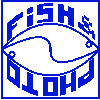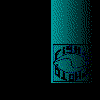

















Heros
c.f. notatus,
Rio Essequibo
Heros notatus, a male,
The choice of the actual fish for this site is a very concious one.
Of course there is something between me and this animal, is there a
certain affinity, but also the knowledge that there is still something
to explore, something to do justice to and the get enjoyment of has
played a important role and we think that we can we can contribute to
sound aquaristics. Ethically, esthetically and for sure when it concerns
the right information.
JOHAN NATTERER Collected
in Brazil from 1817 until 1835 a number of fishes of which nine were
described later on by JACOB HECKEL . Amongst them there were also Heros.
He placed them in the Genus Cichlasoma. In 1983 KULANDER makes
a revision of the Genus in which Heros was admitted again as an independent
specious. Dat de soorten zich gemakkelijk aan uiterlijke kenmerken laten
onderscheiden speelde In that played an important role that the animals
are easily to distinguish at external characteristics.
The most striking characteristic of all Heros-spcies is the high almost
discoid body with the narrow neck and the flatted brest. That gives
undeniable reference to their nearest relatives; the Angelfish , the
Discusfish and the Mesonauta's all with also a distinct pattern of verticals
stripes on the body.
The information below about the occurrence, the biotope and the food of various specimen of Heros I take from DATZ 1995 page. 350 ff and pages 422 ff. ( Who wants to be informed more extensive can consult both article of RAINER STAWIKOWSKI and UWE WERNER. Aquariun Magazin 1983 no 4 page 215 ff. A subscription to Datz in fact is a must for every serious aquarist.) They occur in the whole basin of the Rio Negro and the Orinoco, that of the Essequibo (Rupununi and Potaro and the only rivers at the eastern slopes of the shield of Guyana (fe.Oyapock and Flechal). And in the basin of the Amazon that of the Rio Guaporé and parts of the basin of the Tocantins and the ( see the map on the next page.)